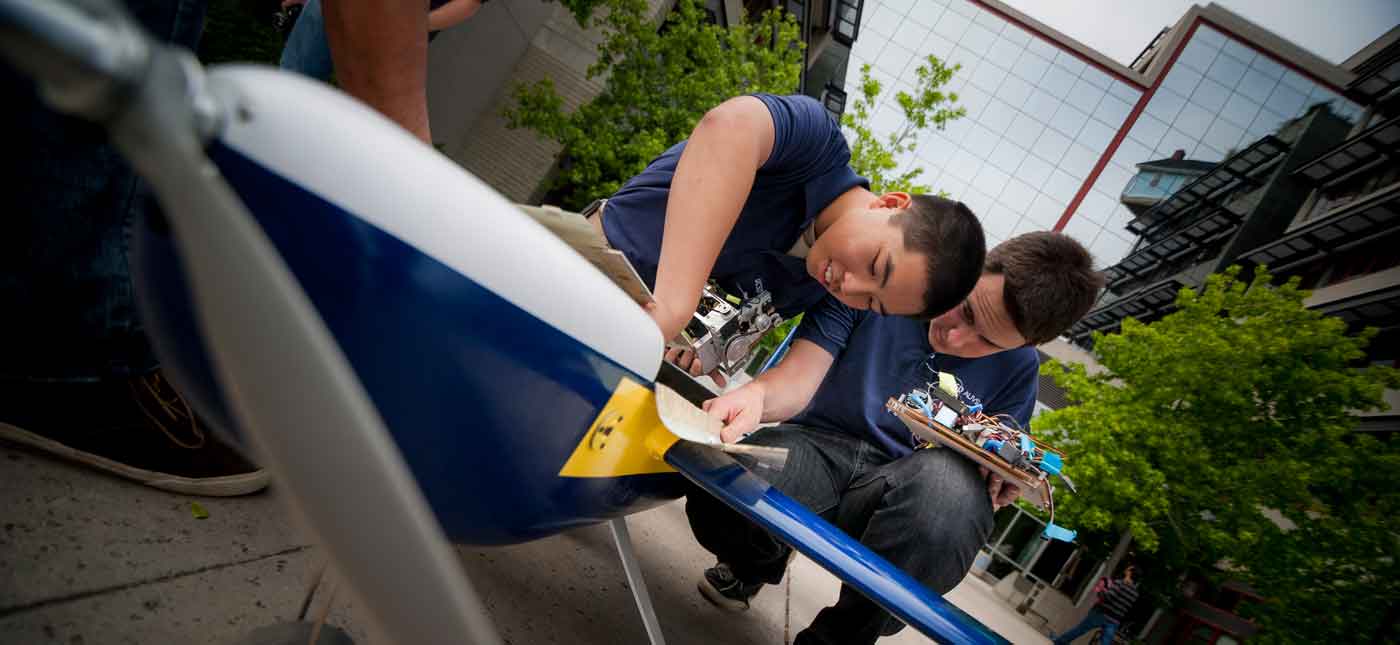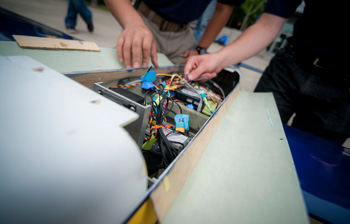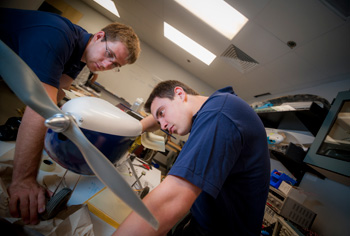
By:
- Ioana Patringenaru
Published Date
By:
- Ioana Patringenaru
Share This:
Engineering Students Gear Up to Compete in National UAV Challenge

Photos by Erik Jepsen/UC San Diego Publications
Their mission: make an unmanned autonomous vehicle, better known as a UAV, take off, fly over specific markers, find five to 11 targets and then land—all in half an hour. That is the challenge that a team of 25 students at UC San Diego is getting ready to tackle next month.
They are taking part in the Student Unmanned Aerial Systems Competition June 20 to 23 at Naval Air Station Patuxent River in Maryland. The winning team can take home as much as $15,000.
Related Story
Use of Drones Raises Questions
Drones are not exactly ubiquitous yet. But that future may not be far away. From geek-chic to deadly, these robotic flying machines range from projects crafted by DIYers and other hobbyists, to the massive, weaponized systems operated by the U.S. military. Just as big as the differences between drones are the questions about them that we, as a society, have yet to fully address. Read the full story >>
There’s more to the challenge: teams must identify targets by a range of characteristics, including their shape, color, any markings they might bear, such as colored letters and numbers, as well as their latitude and longitude. The UC San Diego students said they are fairly confident that they can do well, even though no team to date has been able to meet all the competition’s goals
“If everything goes well, we will probably win,” said Bryan Ritoper, an engineering science major and the team’s airframe lead.
The students say their confidence stems from a sophisticated computer vision system they have worked on for several years. “We’re one of the few teams that uses autonomous recognition of targets,” Ritoper said.
Carrying that sophisticated payload is Falco, a 25-pound autonomous, unmanned aircraft with a 10 ½-foot wingspan that flies at an altitude of 400 feet and a speed of 32 miles per hour. It will be equipped with a Canon T4i DSLR camera that will capture images of the area where the targets are located. A communications system will transmit that data to a ground station that controls the aircraft. The station’s computer will run the images through computer vision software that will identify potential targets. The computer will display these images for the students, so they can confirm that a target has indeed been found.

The team flew the UAV’s maiden flight May 12. Many more are planned leading up to the June competition. The 25 students hail from a wide range of majors, including aerospace, mechanical, electrical and computer engineering, as well as computer science.
The team operates on a $20,000 budget, mostly financed by donations, including $5,000 from Northrop Grumman. Building Falco cost $10,000, including about $1,000 for the composite airframe and $500 for the aircraft’s propulsion system. The rest went to computers, cameras and transmitters. About $7,500 will go to airplane tickets and lodging for the 11 students who will go to compete in the Maryland competition, which is organized by the Association of Unmanned Vehicle Systems International.
The ethics of UAVs
As hobbyists, the students said that they follow strict rules when flying their UAV. The aircraft is always within their line of sight and they always fly below 400 feet, for example. They also said they feel UAVs’ capabilities are exaggerated. “People don’t realize how dumb these things are,” said Tim Wheeler, the team’s project manager.

In other words, it takes a lot of brain power and manpower to make a UAV work. That means the likelihood of rogue drones harming civilians is very low. Students also pointed out that a remote-controlled aircraft has pretty much the same capabilities as UAVs—and equal potential to be used for harm.
They also said that there are many uses for UAVs, not just military ones. For example, students are working with the San Diego Zoo to use UAVs to track iguanas in remote areas of the Dominican Republic. With current technologies, such as hired planes or searchers on the ground, it takes 11 hours to track one animal. Using UAVs would dramatically reduce that time. UAVs can also be used as rescue aircraft in natural disasters or in case of a nuclear accident, the students pointed out.
They also stressed the importance of regulation for UAVs, just as for any other aircraft. “They’re going to need to be certified, just like any other plane,” said Ritoper, the team’s airframe lead.
Share This:
You May Also Like
Stay in the Know
Keep up with all the latest from UC San Diego. Subscribe to the newsletter today.


